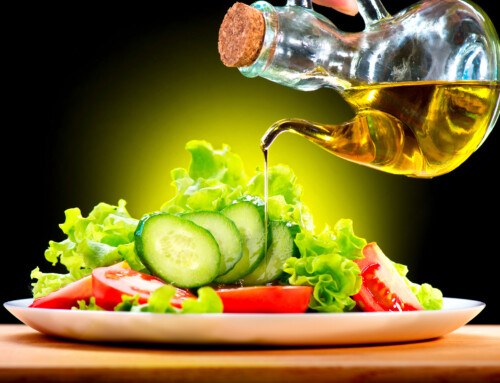This insightful article was provided by Danny Spice. Here are some GREAT tips for those of us who want to achieve a firmer mid section!
Ab Diet Tip 1. Eat more fiber.
Not eating enough fiber may be a major reason women are getting fatter and flabbier. To ditch the fat and show off firm, beautiful abs, you need to eat at least 25 grams of fiber daily, says leading fiber researcher David J.A. Jenkins, M.D., Ph.D., D.Sc., Professor of Nutrition at the University of Toronto, and a member of the National Academy of Sciences (NAS) Food and Nutrition Board. Fiber, which is the indigestible part of fruits, vegetables and whole-grain foods, helps you achieve flat abs.
How to add fiber to your diet comfortably? One cautionary note: It’s important to add fiber slowly but consistently to prevent gas. “Make higher-fiber choices throughout the day; don’t have all your fiber in one bunch,” Jenkins says. “This is particularly important with viscous fiber – a type of soluble fiber found in beans, oats and barley that also has the benefit of lowering blood cholesterol,” he says.
For best results, increase your fiber intake slowly over the course of one month and drink plenty of water to keep food moving through your system as quickly as possible.
Ab Diet Tip 2. Opt for a sensible amount of high-quality carbs.
For flatter abs, make carbs 45–- 65 percent (202 – 292) grams based on an 1,800-calorie diet) of your total daily calories. Balance is the key here, so don’t go below 45 percent (202 grams), or above 65 percent (292 grams), which can lead to water retention, bloating and temporary weight gain that shows up in your middle.
When you eat carbs, they break down into glucose, which is stored as glycogen in the muscles and liver. When glycogen is stored, it carries with it three times its own weight as water, compared to no water at all for protein and fat, according to Peter Garlick, Ph.D., a professor at Stony Brook University in New York. If you eat an extremely high-carb diet, you may store excess water, experience bloating and gain temporary water weight. (This is why people who go on no- or very low-carb diets can initially lose weight so quickly. They’re really just losing water.)
Focus on balanced eating. For best results, eat at least three to five 4-ounce servings of veggies (15 – 25 grams of carbs); two to four 4-ounce servings of fruit (30–60 grams of carbs) and about 1 cup (8 ounces cooked or 2 ounces dry, or 2 slices of bread) of whole grains per meal (90 grams per day).
Ab Diet Tip 3. Drink up!
Many women believe that drinking too much water will give them puffy abs, but just the opposite is true. “Even though we associate water with being bloated, drinking more water can help to flush sodium out of the body, and that reduces the bloat,” said Jeff Hampl, Ph.D., R.D., nutrition researcher and assistant professor at Arizona State University.
Drink at least eight 8-ounce glasses of water per day. Beverages with little or no calories, caffeine or sodium, including herbal tea, are best. Avoid regular soft drinks and soups with lots of sodium. If you are eating plenty of water-rich foods such as fruits, vegetables and low-sodium soups, you can get half of your water requirements from foods, according to a 1998 NAS Food and Nutrition Board report.
Avoid carbonated drinks. Fizzy drinks, including soda pop and spritzers, increase bloating because the carbon dioxide trapped in the bubbles creates gas, which slows down stomach emptying.
Ab Diet Tip 4. Watch the sodium.
Sodium may have a bad rep, but it’s essential for regulating body fluids and blood pressure as well as for nerve transmission, muscle function and absorption of important nutrients. But even a small amount of excess sodium causes bloating.
The American Heart Association recommends you consume no more than 2,400 milligrams of sodium daily — roughly 1 teaspoon of table salt. That’s enough sodium to replenish your supply even if you work up a major sweat.
Choose fresh, natural foods over fast, commercial or packaged foods. Instead of ordering french fries (265 milligrams of sodium), have a baked potato (8 milligrams). Instead of a pickle (1,730 milligrams!), enjoy a fresh cucumber (6 milligrams). And beware of cured meats: Three ounces of ham packs in 1,009 milligrams of sodium, compared to just 48 milligrams for the same amount of roast pork. Soups are also notoriously high in sodium; some canned varieties contain more than 1,100 milligrams per cup. Read labels carefully and stick with low-sodium brands like Healthy Choice.
Ab Diet Tip 5. Eat light at night.
It never fails: You have a heavier-than-normal evening meal or snack, and when you weigh yourself the next morning, you’re up by several pounds. But as depressing as it may seem at the moment, such a quick gain is always water weight; you simply cannot gain that much fat overnight.
In a study conducted by Callaway, people who skipped breakfast or lunch and ate their largest meal later in the day had lower metabolisms. So by eating light at night you’ll receive a double benefit: You’ll wake up with a flatter tummy, and you’ll also have a better appetite for a fiber-rich breakfast, which sets you up for a day of healthful eating. Some tips to get you started:
Eat five times a day. Your body needs food every three to four hours, so instead of eating three large meals, try to schedule five smaller, more frequent meals throughout the day (breakfast-snack-lunch-snack-dinner). By staying full and energized, you’ll avoid hunger pangs, maintain an even energy flow, make better, healthier food choices (no binging or craving) and enjoy the most efficient burning of calories.
Ab Diet Tip 6. Reduce stress.
Research shows that stress triggers the hormone cortisol to turn up your appetite and deposit fat around the organs in your abdomen. Pamela Peeke, M.D., M.P.H., author of Fight Fat After Forty (Penguin, 2000) calls this “toxic weight,” because it’s associated with heart disease, diabetes and cancer.

![3 Ways To Tackle Your Sweet Tooth | Fox 5 Atlanta Good Day Atlanta [VIDEO]](http://mariamore.com/wp-content/uploads/2018/09/IMG_9327-e1537699063252-500x383.jpg)



Leave A Comment